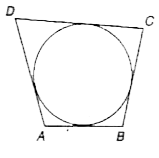A circle touches the sides of a quadrilateral ABCD at P, Q, R and S respectively. Find the angles subtended at the centre by a pair of opposite sides.
180∘
270∘
225∘
None of these
The correct Answer is:A
To find the angles subtended at the center by a pair of opposite sides of a quadrilateral ABCD, where a circle touches the sides at points P, Q, R, and S, we can follow these steps:
1. Understanding the Configuration:
We have a quadrilateral ABCD with a circle inscribed in it. The points where the circle touches the sides are P (on AB), Q (on BC), R (on CD), and S (on DA).
2. Labeling the Angles:
Let O be the center of the circle. We will denote the angles subtended at the center O by the sides of the quadrilateral as follows:
- Angle AOB for side AB
- Angle BOC for side BC
- Angle COD for side CD
- Angle DOA for side DA
3. Using the Properties of Tangents:
From the properties of tangents, we know that the angles subtended by the tangents from a point outside the circle to the points of tangency are equal. Therefore:
- Angle AOP = Angle AOB
- Angle BQO = Angle BOC
- Angle CRQ = Angle COD
- Angle DSO = Angle DOA
4. Summing the Angles:
The sum of all angles around point O is 360 degrees. Thus, we can write the equation:
Angle AOB+Angle BOC+Angle COD+Angle DOA=360∘
5. Identifying Opposite Angles:
We can pair the opposite angles:
- AOB and COD
- BOC and DOA
6. Setting Up the Equations:
Let:
- Angle AOB = x
- Angle BOC = y
- Angle COD = z
- Angle DOA = w
From the sum of angles, we have:
x+y+z+w=360∘
Since opposite angles are equal, we can express:
x+z=180∘(1)
y+w=180∘(2)
7. Conclusion:
From equations (1) and (2), we can conclude that:
- The angles subtended at the center by opposite sides of the quadrilateral are supplementary, meaning:
Angle AOB+Angle COD=180∘
Angle BOC+Angle DOA=180∘
Final Answer:
Thus, the angles subtended at the center by a pair of opposite sides of the quadrilateral ABCD are 180 degrees.
We have a quadrilateral ABCD with a circle inscribed in it. The points where the circle touches the sides are P (on AB), Q (on BC), R (on CD), and S (on DA).
Let O be the center of the circle. We will denote the angles subtended at the center O by the sides of the quadrilateral as follows:
- Angle AOB for side AB
- Angle BOC for side BC
- Angle COD for side CD
- Angle DOA for side DA
From the properties of tangents, we know that the angles subtended by the tangents from a point outside the circle to the points of tangency are equal. Therefore:
- Angle AOP = Angle AOB
- Angle BQO = Angle BOC
- Angle CRQ = Angle COD
- Angle DSO = Angle DOA
The sum of all angles around point O is 360 degrees. Thus, we can write the equation:
Angle AOB+Angle BOC+Angle COD+Angle DOA=360∘
We can pair the opposite angles:
- AOB and COD
- BOC and DOA
Let:
- Angle AOB = x
- Angle BOC = y
- Angle COD = z
- Angle DOA = w
x+y+z+w=360∘
x+z=180∘(1)
y+w=180∘(2)
From equations (1) and (2), we can conclude that:
- The angles subtended at the center by opposite sides of the quadrilateral are supplementary, meaning:
Angle AOB+Angle COD=180∘
Angle BOC+Angle DOA=180∘
Thus, the angles subtended at the center by a pair of opposite sides of the quadrilateral ABCD are 180 degrees.
Topper's Solved these Questions
- BOOK - ADVANCED MATHS BY ABHINAY MATHS ENGLISHCHAPTER - QUADRILATERALEXERCISE - EXERCISE48videos
QUADRILATERAL
- BOOK - ADVANCED MATHS BY ABHINAY MATHS ENGLISHCHAPTER - PROFIT & LOSSEXERCISE - Questions200videos
PROFIT & LOSS
- BOOK - ADVANCED MATHS BY ABHINAY MATHS ENGLISHCHAPTER - RATIO & PROPORTIONEXERCISE - QUESTIONS113videos
RATIO & PROPORTION
Similar Questions
A circle touches the sides of a quadrilateral ABCD at P, Q, R, S respectively. Show that the angles subtended at the centre by a pair of opposite sides are supplementary.
View SolutionType IV: A circle touches the sides of the quadrilateral ABCD at P, Q, R, and S respectively. Show that the angles subtended at the center by a pair of opposite sides are supplementary.
View Solution
Knowledge Check
- Question 1 - Select One
A circle touches a quadrilateral ABCD. Find the true statement:
 AAB+BC=CD+ADBAB+CD=BC+ADCBD=ACDnone of the above
AAB+BC=CD+ADBAB+CD=BC+ADCBD=ACDnone of the above
A circle touches all sides of quadrilateral ABCD then which one of these is true :
View SolutionA circle touches all the four sides of a quadrilateral ABCD . Prove that: AB+CD=BC+DA .
View SolutionA circle touches all the four sides of a quadrilateral ABCD. Prove that AB + CD = BC + DA
View SolutionIf circle touches all the sides of a quadrilateral ABCD, if AB = 7 cm, CD = 3 cm, BC = 8.5 cm. Find the length of AD.
View SolutionIf the sides of a quadrilateral ABCD touch a circle prove that
AB+CD=BC+AD.View SolutionDraw a quadrilateral XYZW and name the pairs of opposite sides.
View SolutionProve that opposite sides of a quadrilateral circumscribing a circle, subtend supplementary angles at the centre of a circle.
View Solution

